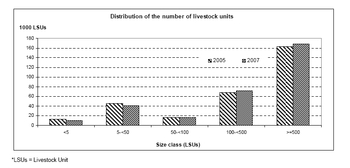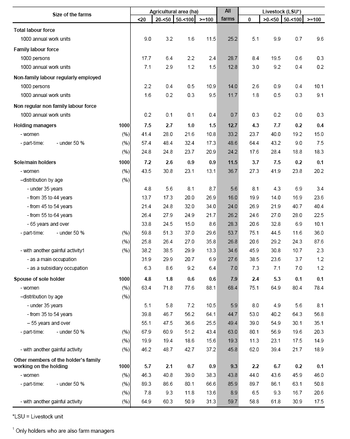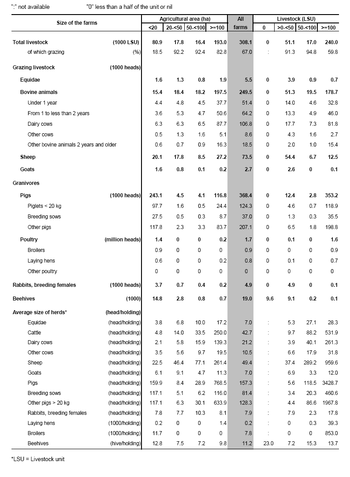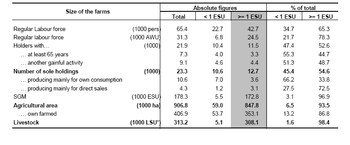Archive:Farm structure in Estonia - 2007 results
- Data from July 2008. Most recent data: Further Eurostat information, Main tables and Database.
This article is part of a series of country-specific essays on the results of the European Union (EU) Farm structure survey (FSS) 2007. It provides a brief but nevertheless comprehensive insight into farm structure in Estonia.
The 2007 FSS recorded 23 300 agricultural holdings in Estonia, which represents a 16 % decrease since 2005. This drop is accompanied by an increase in the utilised agricultural area (UAA), reflecting the decrease in the number of small farms together with the increase in the number of large ones.
Main statistical findings
The utilised agricultural area increased 10 %
In 2007, about 12 700 agricultural holdings in Estonia had an economic size of at least one European size unit (ESU), compared to 13 400 in 2005.
These farms made use of 0.85 million hectares (ha) of utilised agricultural area, (11 % more than in 2005), which makes the average size of a holding in Estonia 67 ha (compared with 57 ha in 2005). See Figure 1 for the distribution of UAA in terms of farm size, while Table 2 describes the size distribution and other characteristics of the agricultural holdings.
These holdings employed 25 200 annual work units (AWUs), the equivalent of 25 200 people working full time, a decrease of 10 % since 2005. The organisation and distribution of the labour force in Estonia is described in Figure 2 and Table 1.
The farms contained 0.3 million livestock unit (LSU) in 2007, 0.5 % less than in 2005. The distribution of livestock by farm size is shown in Table 4 and Figure 3.
Amongst the 12 700 agricultural holdings in 2007:
- 43 % made use of less than one AWU, while another 21 % made use of two or more AWUs;
- 5 % used less than 2 ha (2 % less than in 2005), while 20 % used 50 ha or more;
- 28 % were producing mainly for own consumption, 10% less than in 2005;
- 15 % of the holdings specialised in sheep, goats and other grazing livestock;
- 14 % specialised in cereals, oilseed and protein crops;
- 14 % were engaged in mixed livestock.
30 % of the farms specialised in livestock, and 30 % had a specialisation related to crops. Both figures represent a rise in these specialisations since 2005, when the values were 26 and 28 %, respectively.
Amongst the sole holders:
- 37 % were women in 2007;
- 55 % were aged 55 or more and 6 % were younger than 35 years;
- 40 % had another gainful activity in 2007 (compared with 37.6 % in 2005).
In Estonia in 2007, 42 % of the agricultural area was owned by farmers.
The family labour force labour force has decreased by 16 % from 2005 to 2007.
In 2007, in Estonia there was a 55 % rise in the organically farmed area, to 53 700 ha or 6.3 % of the UAA. The number of holdings with organic farming area increased by 49 % from 2005 to 2007. Details of land use by size of farm are given in Table 3.
The situation for subsistence farming in Estonia is outlined in Table 5.
Data sources and availability
Due to the different coverage of the FSS across Member States, the total number of farms is not comparable between countries. This is why the present analysis, including Tables 1-4 and the graphs focus on holdings of at least one European size unit.
The survey on the structure of agricultural holdings in Estonia was carried out in summer 2007 using a combined method (exhaustive and sample survey). This was the fourth Farm Structure Survey in Estonia; the first one was a full-scale agricultural census conducted in 2001 and two sample surveys were carried out in 2003 and 2005. The reference date of the FSS 2007 was 1st June 2007 and the reference period was the preceding 12 months.
The target population for the FSS 2007 covers all the agricultural holdings having at least 1 ha of UAA or, if the UAA is less than 1 ha, the holdings with an economic size of at least 1 ESU or which production is mainly intended for sale.
The sample frame for the 2007 FSS was the statistical Register of Agricultural Holdings, which is based on the 2001 agricultural census data and is regularly updated by statistical surveys and administrative sources. The largest holdings (economic size 2 ESU or more), the legal entities, the holdings of small-numbered strata (specialised in horticulture, permanent crops and breeding granivores), the organic farms and the units involved in the survey of sown areas in 2007, as well as the new farms were selected exhaustively (altogether 11 328 units).
A 75-stratum stratified simple random sample was drawn from the remaining ones using the economic size, the type of farming and the geographical location as stratification variables. The total number of selected holdings was about 20 000 (70 % of the total in the frame).
In Estonia the FSS 2007 made use of data from the Organic Farming Register for three characteristics. All the new organic farms of this register where added into the completely enumerated stratum.
The data were checked at different levels and times. Arithmetical and logical control procedures were used during the filling in of the questionnaires and also during the data processing. The results of the survey were also compared with the administrative information and data from previous surveys.
Non-response in the Estonian 2007 FSS was 14% of the farms. For completely enumerated strata with non-response the extrapolation factor is corrected proportionately to the nonresponse. The information from previous surveys and administrative data were also used for imputation in particular cases of non-response.
The initial extrapolation factors were adjusted according to the new holdings and in the case of duplicates. In post stratification 45 new strata were composed.
Between FSS 2005 and 2007 "maintaining land in good agricultural and environmental conditions" (GAEC) became an agricultural activity and the concerned land has been included in the agricultural area. In Estonia it covers 45 000 ha, 49 % being in farms with at least 1 ESU.
For each activity (`enterprise`) on a farm (for instance wheat, dairy cow or vineyard), a standard gross margin (SGM) is estimated, based on the area (or the number of heads) and a regional coefficient. The sum of such margins in a farm is its economic size, expressed in European size units (ESU, 1 ESU is a 1200-euro SGM).
An annual work unit (AWU) is equivalent to a worker employed on a full time basis for one year. In Estonia it is 1800 hours (225 working days of 8 working hours per day).
Context
European Commission rural development policy aims to improve competitiveness in agriculture and forestry, improve the environment and countryside, improve the quality of life in rural areas and encourage the diversification of rural economies.
As agriculture has modernised and the importance of industry and services within the economy has increased, so agriculture has become much less important as a source of jobs. Consequently, increasing emphasis is placed on the role farmers can play in rural development, including forestry, biodiversity, the diversification of the rural economy to create alternative jobs and environmental protection in rural areas.
The FSS continues to adapt to provide timely and relevant data to help analyse and follow these developments.
See also
Further Eurostat information
Publications
- Farm Structure Survey in Estonia - 2007 - Statistics in focus 83/2008
- National Methodological Report – FSS 2007 Estonia (available on request)
Main tables
- Agriculture, see:
- Farm structure: historical data (1990-2007) (t_ef)
Database
- Agriculture, see:
- Farm structure (ef)
Dedicated section
- Ad-hoc tables: Farm Structure Survey
Methodology / Metadata
- Farm structure (ESMS metadata file — ef_esms)







